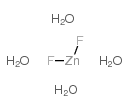13986-18-0
| Name | Zinc Fluoride Tetrahydrate |
|---|---|
| Synonyms |
EINECS 232-001-9
zinc,difluoride,tetrahydrate MFCD00149892 ZINC FLUORIDE TETRAHYDRATE |
| Density | 2,255 g/cm3 |
|---|---|
| Melting Point | 872-910 °C |
| Molecular Formula | F2H8O4Zn |
| Molecular Weight | 175.43800 |
| Exact Mass | 173.96800 |
| PSA | 36.92000 |
| LogP | 0.58070 |
|
Section 1: Product Identification Chemical Name:Zinc fluoride tetrahydrate, 98% CAS Registry Number:13986-18-0 Formula:ZnF2.4H2O EINECS Number:none Chemical Family:metal halide Synonym:Zinc difluoride tetrahydrate
Section 2: Composition and Information on Ingredients IngredientCAS NumberPercentACGIH (TWA)OSHA (PEL) Title Compound13986-18-0100%2.5mg/m3 (as F)2.5mg/m3 (as F) Section 3: Hazards Identification If inhaled or swallowed this compound may cause fluoride poisoning. Early symptoms include nausea, Emergency Overview: vomiting, diarrhea, and weakness. Irritating to skin, eyes and respiratory tract. Primary Routes of Exposure:Contact with skin and eyes. Inhalation of dust. Eye Contact:Causes irritation to the eyes. May cause serious damage. Effects may not immediately appear. Causes irritation, with redness and pain. Soluble fluoride may be corrosive. Effects may not appear Skin Contact: immediately Inhalation of dust causes severe irritation to the respiratory tract. may caues coughing, sore throat and labored Inhalation: breathing. Ingestion:May cause salivation, nausea, vomiting, diarrhea, and abdominal pain. Fluoride poisoning may cause nausea, vomiting, diarrhea, weakness, coma, respiratory failure and Acute Health Affects: cardiovascular collapse. Irritating to skin, eyes and respiratory tract. Prolonged exposure to hydrolysable fluorine compounds can cause deterioration of bone and tooth structure. Chronic Health Affects: Repeated exposure of skin to zinc compounds can cause dermatitis and ulcerations. NTP:No IARC:No OSHA:No SECTION 4: First Aid Measures Immediately flush the eyes with copious amounts of water for at least 10-15 minutes. A victim may need Eye Exposure: assistance in keeping their eye lids open. Get immediate medical attention. Wash the affected area with water. Remove contaminated clothes if necessary. Apply calcium gluconate jelly Skin Exposure: or water soluble calcium salts as antidote. Seek medical assistance. Remove the victim to fresh air. Closely monitor the victim for signs of respiratory problems, such as difficulty Inhalation: in breathing, coughing, wheezing, or pain. In such cases seek immediate medical assistance. Seek medical attention immediately. Keep the victim calm. Give the victim water (only if conscious). Induce Ingestion: vomiting only if directed by medical personnel. SECTION 5: Fire Fighting Measures Flash Point:not applicable Autoignition Temperature:none Explosion Limits:none Extinguishing Medium:None. Material is non-flammable. If this product is involved in a fire, fire fighters should be equipped with a NIOSH approved positive pressure Special Fire Fighting Procedures: self-contained breathing apparatus and full protective clothing. Hazardous Combustion andIf involved in a fire this material may emit corrosive fumes of hydrofluoric acid. Decomposion Products: Unusual Fire or Explosion Hazards: No unusual fire or explosion hazards. SECTION 6: Accidental Release Measures Small spills can be mixed with powdered sodium bicarbonate, lime, or calcium carbonate and swept up. Avoid Spill and Leak Procedures: raising dust. SECTION 7: Handling and Storage Handling and Storage:Store solid in a tightly sealed container. SECTION 8: Exposure Controls and Personal Protection Eye Protection:Always wear approved safety glasses when handling a chemical substance in the laboratory. Skin Protection:Wear protective clothing and gloves. Consult with glove manufacturer to determine the proper type of glove. Ventilation:Solid may form a fine dust. If possible, handle the solid in an efficient fume hood. If in form of fine dust and ventilation is not available a respirator should be worn. The use of respirators Respirator: requires a Respirator Protection Program to be in compliance with 29 CFR 1910.134. Ventilation:Solid may form a fine dust. If possible, handle the solid in an efficient fume hood. Additional Protection:No additional protection required. SECTION 9: Physical and Chemical Properties Color and Form:white xtl. Molecular Weight:103.37 (175.43) Melting Point:no data Boiling Point:no data Vapor Pressure:no data Specific Gravity:2.255 Odor:none Solubility in Water:1.6gm/100cm3 SECTION 10: Stability and Reactivity Stability:air and moisture stable Hazardous Polymerization:no hazardous polymerization Conditions to Avoid:none Incompatibility:none Decomposition Products:Metal fluorides and water SECTION 11: Toxicological Information RTECS Data:No information available in the RTECS files. Carcinogenic Effects:no data Mutagenic Effects:no data Tetratogenic Effects:no data SECTION 12: Ecological Information Ecological Information:No information available SECTION 13: Disposal Considerations Disposal:Dispose of according to local, state and federal regulations. SECTION 14: Transportation Shipping Name (CFR):Non-hazardous Hazard Class (CFR):NA Additional Hazard Class (CFR):NA Packaging Group (CFR):NA UN ID Number (CFR):NA Shipping Name (IATA):Non-hazardous Hazard Class (IATA):NA Additional Hazard Class (IATA):NA Packaging Group (IATA):NA UN ID Number (IATA):NA SECTION 15: Regulatory Information TSCA:Not listed in the TSCA inventory. SARA (Title 313):Title compound: See Category Code N982 for reporting. Second Ingredient:none SECTION 16 - ADDITIONAL INFORMATION N/A |
| Hazard Codes | Xi,T:Toxic; |
|---|---|
| Risk Phrases | R36/37/38 |
| Safety Phrases | S37/39-S26 |
| RIDADR | 3288 |
| Packaging Group | III |
| Hazard Class | 6.1 |
|
~% 
13986-18-0 |
| Literature: Spectrochimica Acta, Part A: Molecular and Biomolecular Spectroscopy, , vol. 47, # 11 p. 1595 - 1605 |

